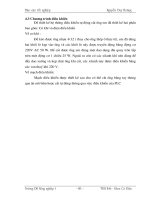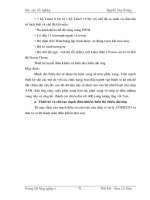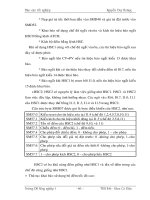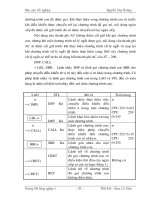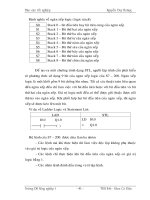Cấu tạo thép tòa nhà - P3
Bạn đang xem bản rút gọn của tài liệu. Xem và tải ngay bản đầy đủ của tài liệu tại đây (404.32 KB, 13 trang )
25
1.3 Frame loadings
The frame of a building is designed to constantly cope with all gravitational loads (self
weight, walls, floors, cars, furniture, humans etc). It should also be capable to
periodically cope with loads such as wind pressure and snow and even take into
account possible thermal effects.
In every building such as the above, there are constant (dead) and moving (live) loads which are
imposed upon the frame. Live loads are usually smaller than dead loads, e.g. 3 people and all furniture
of the sitting room weight less than 1cm
2
of a slab whistle a car weights almost the same as only one
beam.
Abstracts from the book of Apostolos Constandinides titled ‘Earthquake resistant buildings’, Vol. A, chapter 1.3
published in low resolution in the site of pi-Systems International S.A. www.pi.gr
26
Apart from coping with usual loadings, in areas with intense earthquake activity the
frame should be designed with a surplus of bearing strength distributed in such a
way that in the rare but crucial moments of an extreme earthquake to ensure the
stability of the building and avoid extensive damages.
The most characteristic attribute of an element is its mass. The type of forces
imposed upon an element depends on the force field that the element is surrounded
from. Earth’s gravitational field creates the force of gravity commonly referred as
weight. What is more, during an earthquake there are horizontal accelerations that
create the horizontal forces of the earthquake. These forces are imposed upon the
building and create the loadings of the frame. These loads can be categorized as
gravitational loads, wind loads and earthquake loads.
1.3.1. GRAVITATIONAL LOADS
The loads in a building are divided into permanent (dead) and moving (live) loads.
The dead loads consist of the self weight of the reinforced concrete structural
elements, the weight of walls and the weight of all coverings and coatings. As live
loads we consider all loads from humans, furniture, vehicles etc.
Abstracts from the book of Apostolos Constandinides titled ‘Earthquake resistant buildings’, Vol. A, chapter 1.3
published in low resolution in the site of pi-Systems International S.A. www.pi.gr
27
Dead Loads
The density and corresponding specific weight of the materials used in construction
are as follows:
Reinforced concrete ρ=2.50t/m
3
(ε=25.0 kN/ m
3
)
Lightweight regulating concrete ρ=0.80t/m
3
(ε=8.0 kN/m
3
)
Sand mixture ρ=2.00t/m
3
(ε=20.0 kN/m
3
)
Marble ρ=2.70t/m
3
(ε=27.0 kN/m
3
)
The total dead loads of one m
2
for the slab in the above picture is
g=0.15*2.50+0.04*0.8+0.02*2.0+0.02*2.7=0.5t. Summarizing, the self weight of one
cm2 of an ordinary slab is 0.5t (weight 5.0 kN)
Abstracts from the book of Apostolos Constandinides titled ‘Earthquake resistant buildings’, Vol. A, chapter 1.3
published in low resolution in the site of pi-Systems International S.A. www.pi.gr
28
Water ρ=1.00t/m
3
(ε=10.0 kN/m
3
)
The dead load of one m
2
of a slab in a swimming pool filled with 1m of water is 1.4t
(weight 14.0 kN)
Land soil ρ=1.70t/m
3
(ε=17.0 kN/m
3
)
The dead load of one m
2
of a slab in a garden filled with 1m of soil is 2.1t (weight
21.0 kN)
Abstracts from the book of Apostolos Constandinides titled ‘Earthquake resistant buildings’, Vol. A, chapter 1.3
published in low resolution in the site of pi-Systems International S.A. www.pi.gr
29
Abstracts from the book of Apostolos Constandinides titled ‘Earthquake resistant buildings’, Vol. A, chapter 1.3
published in low resolution in the site of pi-Systems International S.A. www.pi.gr

